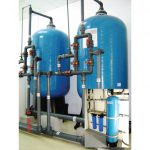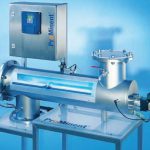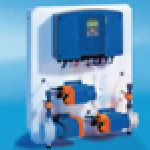Brackish water
 Reverse osmosis, also known as hyper filtration, is used by Brackish Water Reverse Osmosis Systems to purify water and remove salts and other impurities. It is also capable of rejecting bacteria, sugars, proteins, particles, dyes, and other constituents that have a molecular weight of greater than 150-250 Dalton.
Reverse osmosis, also known as hyper filtration, is used by Brackish Water Reverse Osmosis Systems to purify water and remove salts and other impurities. It is also capable of rejecting bacteria, sugars, proteins, particles, dyes, and other constituents that have a molecular weight of greater than 150-250 Dalton.
Sea Water
 From Water makers to Industrial Sized seawater reverse osmosis systems, we offer a full range of Seawater Desalination Reverse Osmosis Systems.
From Water makers to Industrial Sized seawater reverse osmosis systems, we offer a full range of Seawater Desalination Reverse Osmosis Systems.
Our seawater reverse osmosis systems feature advanced and high rejection Reverse Osmosis (R/O) technology. Our designs are state-of-the-art, optimizing efficiency, reliability, product water quality, and overall low cost per unit of water.
Skid mounted and containerized
 We engineer any water treatment system in a containerized version with various available options.
We engineer any water treatment system in a containerized version with various available options.
Containerization of a water treatment plant includes the container and complete installation of the plant including:
- Interconnecting piping between components and systems
- Cabling and wiring of instrumentation inside the container to main control cabinet.
- Operations and Maintenance manuals
- General Arrangement 3D/2D CAD drawings
Multimedia / Sand / Dual Media Filter
 Multimedia Filter Systems also known as depth filters or turbidity filters contain two or more types of media and gravel under-bedding. The gravel is used as a support to keep smaller medias out of the distribution system and to stop channeling of water. Our multimedia system is designed for the removal of turbidity in the water caused by sand, silt, iron and oxidized manganese or sulfur. They are used in applications such as chlorination filtration systems, general turbidity removal and prior to ultraviolet sterilizers or water softeners.
Multimedia Filter Systems also known as depth filters or turbidity filters contain two or more types of media and gravel under-bedding. The gravel is used as a support to keep smaller medias out of the distribution system and to stop channeling of water. Our multimedia system is designed for the removal of turbidity in the water caused by sand, silt, iron and oxidized manganese or sulfur. They are used in applications such as chlorination filtration systems, general turbidity removal and prior to ultraviolet sterilizers or water softeners.
Carbon Filter
 Carbon is a substance that has a long history of being used to absorb impurities and is perhaps the most powerful absorbent known to man. One pound of carbon contains a surface area of roughly 125 acres and can absorb literally thousands of different chemicals. Activated carbon is carbon which has a slight electro-positive charge added to it, making it even more attractive to chemicals and impurities. As the water passes over the positively charged carbon surface, the negative ions of the contaminants are drawn to the surface of the carbon granules.
Carbon is a substance that has a long history of being used to absorb impurities and is perhaps the most powerful absorbent known to man. One pound of carbon contains a surface area of roughly 125 acres and can absorb literally thousands of different chemicals. Activated carbon is carbon which has a slight electro-positive charge added to it, making it even more attractive to chemicals and impurities. As the water passes over the positively charged carbon surface, the negative ions of the contaminants are drawn to the surface of the carbon granules.
Activated carbon filters used for home water treatment typically contain either granular activated carbon (GAC) or powdered block carbon. Although both are effective, carbon block filters generally have a higher contaminant removal ratio. The two most important factors affecting the efficiency of activated carbon filtration are the amount of carbon in the unit and the amount of time the contaminant spends in contact with it. The more carbon the better. Similarly, the lower the flow rate of the water, the more time that contaminants will be in contact with the carbon, and the more absorption that will take place. Particle size also affects removal rates.
Iron removal filter
 Most iron filtration systems operate on the principal of oxidizing the iron (oxidation) to convert it from a ferrous (dissolved or soluble) to a ferric or undissolved state. Once in the ferric state, iron can be filtered.
Most iron filtration systems operate on the principal of oxidizing the iron (oxidation) to convert it from a ferrous (dissolved or soluble) to a ferric or undissolved state. Once in the ferric state, iron can be filtered.
Water filters are the most widely used equipment in removing iron. Its popularity comes from its versatility due to the various media products available and the process involved with each media.
Bag Filter
 Bag Filters are the workhorse of the filtration industry. Finer and more carefully controlled construction in the manufacturing of filter bags have moved bag filters into filtration areas that they had never seen before. In general, Felt Type Filter Bags are finer and offer higher solids loading capacity at 150 microns and below. Above 150 Microns Mesh Type Filter Bags dominate in their more traditional straining applications. Most Bag filters are also designed disposable, which means that they have to be replaced when the filter is clogged.
Bag Filters are the workhorse of the filtration industry. Finer and more carefully controlled construction in the manufacturing of filter bags have moved bag filters into filtration areas that they had never seen before. In general, Felt Type Filter Bags are finer and offer higher solids loading capacity at 150 microns and below. Above 150 Microns Mesh Type Filter Bags dominate in their more traditional straining applications. Most Bag filters are also designed disposable, which means that they have to be replaced when the filter is clogged.
Automatic and manual Control valves
 We offer more than 20 models with 90 different options and over 1,000 configurations. That way, you have a valve that sets you apart – something unique to use as you target specific customer needs.
We offer more than 20 models with 90 different options and over 1,000 configurations. That way, you have a valve that sets you apart – something unique to use as you target specific customer needs.
Self Cleaning Filters
 Self-cleaning water filters, automatic water filters and strainers, for use as industrial water filters, irrigation filters, cooling tower filters and more.
Self-cleaning water filters, automatic water filters and strainers, for use as industrial water filters, irrigation filters, cooling tower filters and more.
Centrifugal Separators
 Centrifugal Separators employ centrifugal action to remove troublesome solids from liquids which will:
Centrifugal Separators employ centrifugal action to remove troublesome solids from liquids which will:
- Extend the effective life of process liquids.
- Protect process equipment from abrasive wear and fouling.
- Control or eliminate waste/solids.
- Reduce downtime and maintenance.
- Keep your fluids systems operating at optimum efficiency.
Ultrafiltration
 Ultrafiltration (UF) is a variety of membrane filtration in which hydrostatic pressure forces a liquid against a semipermeable membrane. Suspended solids and solutes of high molecular weight are retained, while water and low molecular weight solutes pass through the membrane. This separation process is used in industry and research for purifying and concentrating macromolecular (103 – 106 Da) solutions, especially protein solutions. Ultrafiltration is not fundamentally different from microfiltration or nanofiltration, except in terms of the size of the molecules it retains. Ultrafiltration is applied in cross-flow or dead-end mode and separation in ultrafiltration undergoes concentration polarization.
Ultrafiltration (UF) is a variety of membrane filtration in which hydrostatic pressure forces a liquid against a semipermeable membrane. Suspended solids and solutes of high molecular weight are retained, while water and low molecular weight solutes pass through the membrane. This separation process is used in industry and research for purifying and concentrating macromolecular (103 – 106 Da) solutions, especially protein solutions. Ultrafiltration is not fundamentally different from microfiltration or nanofiltration, except in terms of the size of the molecules it retains. Ultrafiltration is applied in cross-flow or dead-end mode and separation in ultrafiltration undergoes concentration polarization.
Nano filtration
 Nanofiltration is a relatively recent membrane filtration process used most often with low total dissolved solids water such as surface water and fresh groundwater, with the purpose of softening (polyvalent cation removal) and removal of disinfection by-product precursors such as natural organic matter and synthetic organic matter.
Nanofiltration is a relatively recent membrane filtration process used most often with low total dissolved solids water such as surface water and fresh groundwater, with the purpose of softening (polyvalent cation removal) and removal of disinfection by-product precursors such as natural organic matter and synthetic organic matter.
Nanofiltration is also becoming more widely used in food processing applications such as dairy, for simultaneous concentration and partial (monovalent ion) demineralisation.
Water softeners
We call water “hard” if it contains a lot of calcium or magnesium dissolved in it. Hard water causes two problems:
- It can cause “scale” to form on the inside of pipes, water heaters, tea kettles and so on. The calcium and magnesium precipitate out of the water and stick to things. The scale doesn’t conduct heat well and it also reduces the flow through pipes. Eventually, pipes can become completely clogged.
- It reacts with soap to form a sticky scum, and also reduces the soap’s ability to lather. Since most of us like to wash with soap, hard water makes a bath or shower less productive.
 The solution to hard water is either to filter the water by distillation or reverse osmosis to remove the calcium and magnesium, or to use a water softener. Filtration would be extremely expensive to use for all the water in a house, so water softener is usually a less costly solution.
The solution to hard water is either to filter the water by distillation or reverse osmosis to remove the calcium and magnesium, or to use a water softener. Filtration would be extremely expensive to use for all the water in a house, so water softener is usually a less costly solution.
The idea behind a water softener is simple. The calcium and magnesium ions in the water are replaced with sodium ions. Since sodium does not precipitate out in pipes or react badly with soap, both of the problems of hard water are eliminated. To do the ion replacement, the water in the house runs through a bed of small plastic beads or through a chemical matrix called zeolite. The beads or zeolite are covered with sodium ions. As the water flows past the sodium ions, they swap places with the calcium and magnesium ions. Eventually, the beads or zeolite contain nothing but calcium and magnesium and no sodium, and at this point they stop softening the water. It is then time to regenerate the beads or zeolite.
Regeneration involves soaking the beads or zeolite in a stream of sodium ions. Salt is sodium chloride, so the water softener mixes up a very strong brine solution and flushes it through the zeolite or beads (this is why you load up a water softener with salt). The strong brine displaces all of the calcium and magnesium that has built up in the zeolite or beads and replaces it again with sodium. The remaining brine plus all of the calcium and magnesium is flushed out through a drain pipe. Regeneration can create a lot of salty water, by the way — something like 25 gallons (95 liters).
Demineralizers, Mixed Bed & Separate Bed
 We are a leading manufacturer of industrial water demineralizer and deionizer (DI) equipment designed for the economical and efficient removal of dissolved salts and minerals. These water treatment systems produce high purity water for commercial and industrial applications. Our design manufactures a complete line of DI systems to meet your water quality requirements.
We are a leading manufacturer of industrial water demineralizer and deionizer (DI) equipment designed for the economical and efficient removal of dissolved salts and minerals. These water treatment systems produce high purity water for commercial and industrial applications. Our design manufactures a complete line of DI systems to meet your water quality requirements.
De Alkalinizer
 Dealkalization refers to the removal of alkalinity ions from water. There are different methods that can be used for alkalinity removal, chloride cycle. Dealkalization is perhaps the simplest and can prove to be very cost effective in many situations.
Dealkalization refers to the removal of alkalinity ions from water. There are different methods that can be used for alkalinity removal, chloride cycle. Dealkalization is perhaps the simplest and can prove to be very cost effective in many situations.
Electrodeionization (EDI)
 Electrodeionization (EDI) is usually considered a water treatment technology that utilizes an electrode to ionize water atoms and separate dissolved ions (impurities) from water. It differs from other water purification technologies, that it is done without the use of chemicals and is usually a tertiary treatment to reverse osmosis(RO).
Electrodeionization (EDI) is usually considered a water treatment technology that utilizes an electrode to ionize water atoms and separate dissolved ions (impurities) from water. It differs from other water purification technologies, that it is done without the use of chemicals and is usually a tertiary treatment to reverse osmosis(RO).
Chlorination
 Chlorination is the process of adding the element Chlorine to water as a method of water purification to make it fit for human consumption as drinking water. Water which has been treated with chlorine is effective in preventing the spread of water born disease.
Chlorination is the process of adding the element Chlorine to water as a method of water purification to make it fit for human consumption as drinking water. Water which has been treated with chlorine is effective in preventing the spread of water born disease.
UV systems
 Our tried and tested systems for the treatment of drinking water and process water: also ideal for reduction of ozone, chlorine or chlorine dioxide in production water in the food and cosmetic industry, and for reduction of chlorine in smaller swimming pools.
Our tried and tested systems for the treatment of drinking water and process water: also ideal for reduction of ozone, chlorine or chlorine dioxide in production water in the food and cosmetic industry, and for reduction of chlorine in smaller swimming pools.
Chlorine dioxide systems
 Chlorine dioxide is an extremely reactive gas, because of its instability cannot be stored, and must only be produced in the required quantities in special plants on the site where it is to be used. Chlorine dioxide offers a number of advantages for water disinfection compared with chlorine, the disinfectant mainly used.
Chlorine dioxide is an extremely reactive gas, because of its instability cannot be stored, and must only be produced in the required quantities in special plants on the site where it is to be used. Chlorine dioxide offers a number of advantages for water disinfection compared with chlorine, the disinfectant mainly used.
Electrolytic chlorine generators
 This generator produces chlorine directly in to the pool or spa from a low concentration of salt added to the pool water. (The pool has salt added to it). Electrolysis takes place in an electrolytic cell installed “in-line” in the re-circulation system. Thus the name. Inside the cell are layers of plates that are electrically charged by a separate power supply. Depending on the generator you need to maintain a salt concentration of about 2500-6000 parts per million in the pool or spa for the unit to operate effectively. This means adding 100-250 kg of salt per 40,000 liters of water .
This generator produces chlorine directly in to the pool or spa from a low concentration of salt added to the pool water. (The pool has salt added to it). Electrolysis takes place in an electrolytic cell installed “in-line” in the re-circulation system. Thus the name. Inside the cell are layers of plates that are electrically charged by a separate power supply. Depending on the generator you need to maintain a salt concentration of about 2500-6000 parts per million in the pool or spa for the unit to operate effectively. This means adding 100-250 kg of salt per 40,000 liters of water .
